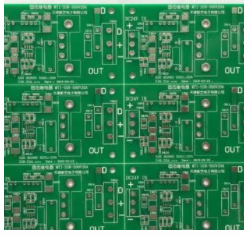The PCB tin sinking process is specially designed for the benefit of SMT and chip packaging to deposit tin metal coating on the copper surface chemically. It is a new green and environmentally friendly process that replaces the Pb-Sn alloy coating process. It has been widely used in electronic products., Hardware, decorations, etc. There are two more commonly used processes for printed circuit boards: tin spraying and tin sinking. Tin spraying is mainly to directly intrude the PCB board into the molten tin paste. After being leveled by hot air, a dense tin layer will be formed on the copper surface of the PCB, with a thickness of generally 1um-40um. Immersion tin mainly uses displacement reaction to form a very thin tin layer on the PCB surface. The thickness of the tin layer is about 0.8um-1.2um. The tin-immersion process is more commonly used in the surface treatment process of the circuit board.
Chemical tin deposition is a kind of PCB tin deposition process, which is widely used. Its working principle is to change the chemical potential of copper ions to cause the stannous ions in the plating solution to undergo a chemical substitution reaction, which is essentially an electrochemical reaction. The reduced tin metal is deposited on the surface of the copper substrate to form a tin plating layer, and the metal complex adsorbed on the immersion tin plating layer catalyzes the reduction of tin ions to metallic tin, so that the tin ions continue to be reduced to tin. The chemical reaction equation is 2Cu+4TU+Sn2-2Cu+(TU)2+Sn.

The thickness of the sprayed tin layer is about 1um-40um, the surface structure is relatively dense, the hardness is large, and it is not easy to scratch; the sprayed tin only has pure tin in the production process, so the surface is easy to clean, and it can be stored for one year at normal temperature, And the problem of surface discoloration is not easy to occur during the welding process; the tin thickness is about 0.8um-1.2um, the surface structure is relatively loose, the hardness is small, and the surface is easily scratched; the tin sinking is complicated There are many chemical reactions, so it is not easy to clean, and the surface is easy to have syrup, which causes the problem of discoloration during welding. The storage time is short. It can be stored at normal temperature for three months. If it takes a long time, it will change color.
The main defects of chemical tin-immersed plates are the dark tin surface and poor solderability caused by tin surface contamination. After a large amount of data analysis and on-site investigation, it is basically determined that the causes are mainly caused by the following aspects. First, the production process liquid Towing consumption: due to the high viscosity of the tin bath liquid, the output of the tin bath liquid is large, which leads to a large consumption of the tin bath liquid. At the same time, because the tin bath bath liquid is brought into the thiourea washing tank in large quantities, the copper content of the thiourea washing tank rises quickly, which affects the cleaning effect of the production board, and is easy to produce defects such as darkening of the tin surface of the production board., Waste solid thiourea; secondly, the baking time is not appropriate; thirdly, at the end of chemical tin processing, the tin surface is not cleaned cleanly due to the severe drag of the bath liquid at the end of the chemical tin processing, resulting in poor solderability.
Similarities and differences between spray tin and sink tin:
Same point
Both tin spraying and tin immersion processes are surface treatment methods to meet the requirements of lead-free soldering.
difference
Process flow: tin spraying, pre-treatment-tin spraying-testing-molding-appearance inspection; tin sinking, testing-chemical treatment-tin sinking-molding-appearance inspection
Process principle: spraying tin is mainly to intrude the PCB board directly into the molten tin paste. After being leveled by hot air, a dense tin layer will be formed on the copper surface of the PCB. Immersion tin mainly uses displacement reaction to form a very thin tin layer on the PCB surface.
Physical characteristics: spray tin, the thickness of the tin layer is between 1um-40um, the surface structure is relatively dense, the hardness is greater, and it is not easy to scratch; the spray tin only has pure tin in the production process, so the surface is easy to clean, under normal temperature It can be stored for one year, and the problem of surface discoloration is not easy to occur during the welding process; the thickness of tin is about 0.8um-1.2um, the surface structure is relatively loose, the hardness is small, and it is easy to cause surface scratches; After a complex chemical reaction, there are many chemicals, so it is not easy to clean, and the surface is easy to leave the liquid, which leads to the problem of different colors during welding. The storage time is short. It can be stored for three months at normal temperature. If it takes a long time, it will appear. Discoloration
Appearance characteristics: spray tin, the surface is brighter and beautiful; sink tin, the surface is light white, dull, easy to change color.